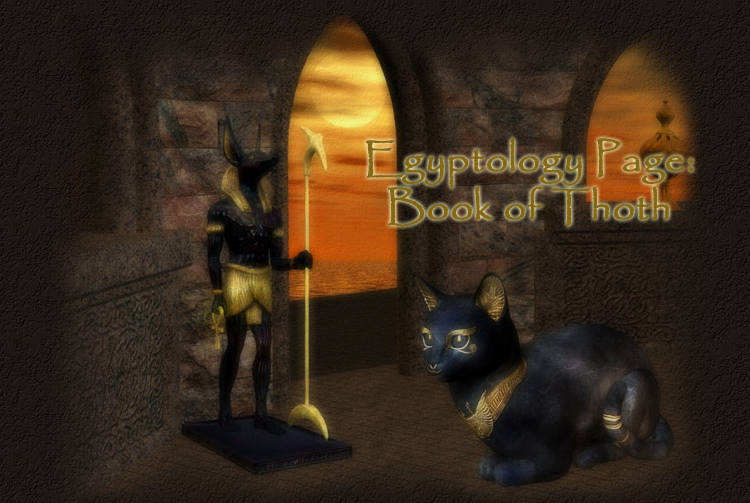Hieroglyphic
Hieratic
Demotic/Enchorial
Hieroglyphic
At the risk of sounding patronizing, I put at the head of this section "Hieroglyphic" to describe that it is going to talk about the hieroglyphic script of Ancient Egypt--"hieroglyphic" here being the adjective of the word "hieroglyph," which is a noun. Some scholars will happily and without much thought use them interchangeably, which is quite forgivable, but I will use them correctly: following is a short introduction on hieroglyphs or hieroglyphic script.
Starting from ca. 5,000 B.C.E. just until the end of the Ptolemies' rule over Egypt (about 100 B.C.E.), the most eminent characteristic
associated with Ancient Egyptian documentation was the hieroglyph. To the ancients, writing was not just a method of expressing
one's thoughts or recording information, but it was sacred: the Ancient Egyptians called this script
medw netjer; in English, it means "the god's words."
The word "hieroglyph" is not Ancient Egyptian, but Greek: "hieros" means "sacred" and "glypho" means "carved" in said language. Moderns use this word to describe this Egyptian picture writing because, in the Graeco-Roman Period (more prominent during this
time, but equally employed during the Egyptian rule over Egypt), hieroglyphic writing was exclusively utilized in carving religious
inscriptions onto temple walls or in composing public monuments. Some of the surfaces on which the Egyptians wrote hieroglyphs were stone (which included
on tomb or temple walls, stelae, and the sides of sarcophagi); wooden coffins; gold jewelry; calcite vessels; and papyri.
Wherever they were written and in whatever context, hieroglyphs were very elaborate and detailed. Sometimes scribes added
color to their hieroglyphic writing: glyphs representing celestial objects, metal vessels, and water were painted blue; those representing animals, birds and reptiles
were painted as close to their natural colors as possible; Egyptian men and body parts were painted red; Egyptian women
were painted yellow or a pinky-brown; and plant life was indicated with green. However, identifying
hieroglyphs with color is only partially useful, for some artists or scribes were not consistent with colors.
One can read and write hieroglyphs from left to right or from right to left--horizontally or vertically (hieroglyphic sentences are not read from the bottom up--this is a misconception due to the way scholars translate kings' names. For example, one reads the Horus Name of Tutankhamun as "Neb-Kheper-Ra" rather than how it is pictured: "Ra-Kheper-Neb").
Egyptians with writing skills were therefore not limited to writing in one direction--that is to say, as long as they maintained symmetry in composing hieroglyphs, something about which they were very particular.
For example, one might find a tomb wall that reads right to left on one side and left to right on the other side. The only thing to remember in reading hieroglyphic
inscriptions is the following: in whatever direction the figures face will be the way one reads them.
Developed over time, hieroglyphs could be used in a number of ways:
As An Ideograph
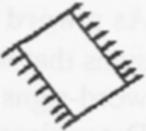

In this case, one uses certain hieroglyphs that represent ideas. The hieroglyph to the left represents a wall falling down--that
represents the
idea of falling. The hieroglyph on the right represents a hall in which wise men made deliberations.
This ideograph represents the
idea of counsel.
With Phonetic Value


A hieroglyphic inscription can be expressed by a sound either syllabically or alphabetically. Examples of syllabically expressed
hieroglyphs include the glyphs pictured above: a picture of a feather represents syllabically the Egyptian word
ma'at, which means "truth" or "justice;" a picture of a beetle represents syllabically the Egyptian word
kheper.
A hieroglyph that has alphabetical value is best illustrated with the Ancient Egyptian alphabet, where a selected group of glyphs represent one letter--
click here to view.
With Poly-Phonetic Value
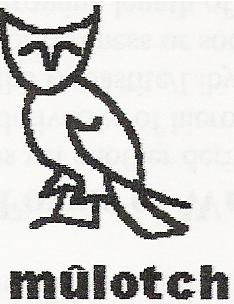
Hieroglyphs that have poly-phonetic value have more than one phonetic value, more than one syllabic or alphabetic value. For example, the hieroglyph pictured above has a syllabic value (
mulotch, which in Ancient Egyptian means "owl") and an alphabetic value (an owl hieroglyph represents the letter "M" in the Egyptian alphabet).
With Homo-Phonetic Value
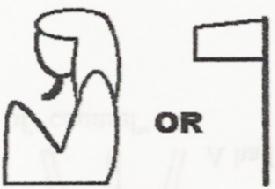
Hieroglyphs with homo-phonetic value are ideographs that represent entirely different objects, but have similar values or meanings. In
other words, two different phonetic hieroglyphs (see above) that mean the same thing have homo-phonetic value. In English we call words with homo-phonetic value synonyms (i.e. "ancient" and "antique" both mean "very old").
As A Word With One Or More Determinatives
Determinatives are hieroglyphic signs that were primarily used in post-dynastic texts and were added signs to word-signs that
helped indicate the meaning and the sounds of written words. Determinatives appear in two forms: those that determine a single
species and those that determine a whole class. There are Egyptian words that use no determinatives or that use one or more. An example of a
word with no determinative is labeled below.
(#1) An example of a word with one determinative is labeled also below.
(#2) For this hieroglyphic word, the glyph in red is the determinative and indicates that the word
ankh means flower. An
example of a word with two determinatives is labeled below.
(#3) For this hieroglyphic word, the first glyph in red is a determinative and represents a bud; the second glyph in red is
a determinative that represents a flower. Together, along with the alphabetical hieroglyphs, they form the word
renpit which means
"flowers". The three vertical lines below the second determinative, in red, indicate that the word is plural.


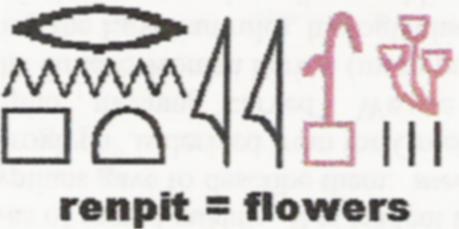 As A Word With A Phonetic Compliment
As A Word With A Phonetic Compliment
A hieroglyph with a phonetic compliment is where there is an alphabetic sign at the end of the word that helps in the reading
of the word. This may sound similar to the duty of a determinative, except for one difference: in many words, the last letter
of the value of a syllabic sign is often written in order to guide the reader an indication or its pronunciation, rather than its meaning.
An example of a word with a phonetic compliment is found below. The hieroglyph in dark yellow, by itself, reads
mester; the hieroglyph
in green is a phonetic compliment that indicates that this word should be read as
mestem: the hieroglyph in red is a determinative,
which indicates that this word means "eye paint" or "that which is painted under the eye."
This is generally the earmark of New Kingdom hieroglyphic writing; Old and Middle Kingdom texts don't exhibit this, except during the reign of Hatshepsut, who was probably the first to use this latest rule of hieroglyphic writing. Also, it is one of the easiest ways to determine in what empire a particular text was written; the difference between Old and Middle Kingdom texts is generally based on prose.
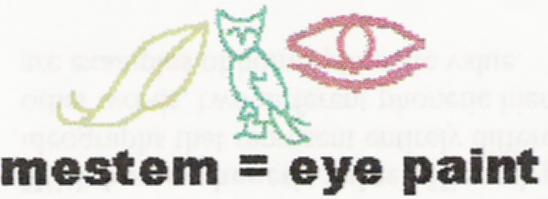 Back to Top
Hieratic
Back to Top
Hieratic
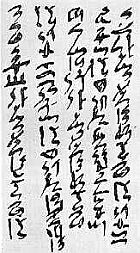
Hieratic is the cursive form of hieroglyphic writing, which came into use around 3100 B.C.E. Typically, priests and scribes used this variation
of writing to document long texts chronicling the political, economic, and agricultural aspects
of the area in which a ruler reigned. Hieratic was also used to record religious and literary texts.
As one can see, hieroglyphs takes some time to write--what with all the details one must put into drawing each pictoglyph--thus,
using hieratic to record important things is less time-consuming. Just like hieroglyphs, one can write them horizontally or
vertically and read them from right to left.
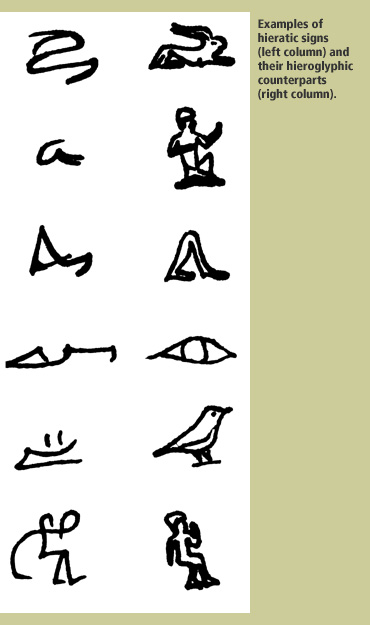
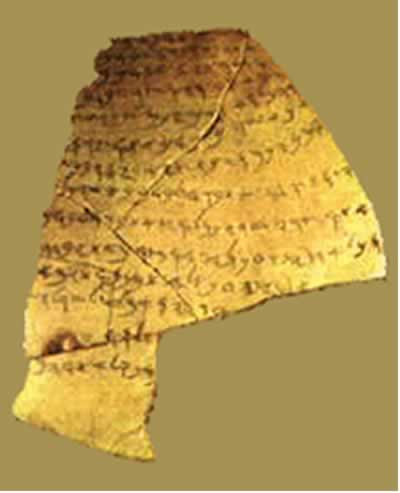
It was extremely rare for one to use hieratic to inscribe monuments, but not rare for it to be used to decorate limestone
ostraca (flakes of limestone that were used popularly as surface material for writing) or on the walls of tombs and temples (hieratic on these surfaces were
often in the form of graffiti).
Back to Top
Demotic/Enchorial
Enchorial or demotic writing is yet another derivative of writing, this time of hieratic, the derivative
of hieroglyphic writing. Egyptians used enchorial/demotic around 900 B.C.E. (during this time, Dynasty XXII Bubastite/Libyan rulers reigned over Egypt).
It was used primarily for business or social purposes. The usage of demotic came about because of the growing length
of particular works, such as royal decrees. A leading example of the usage of demotic is that which one can find written
on the Canopus Stone (also called the Canopus Decree, a stelae that is inscribed with hieroglyphic script, demotic, and Greek writing, dating to about 247-222
B.C.E.). This document proved useful to scholars engaged in the decipherment of the Ancient Egyptian language because it could be compared with the Rosetta Stone, which was also written in hieroglyphs,
demotic, and Greek.
The Canopus Decree


 The Rosetta Stone
The Rosetta Stone

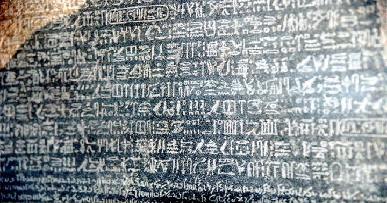
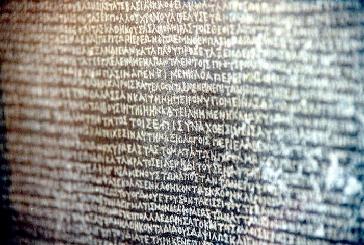 Back to Top
Back to Top
